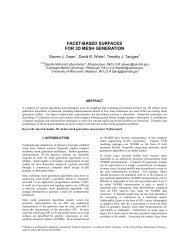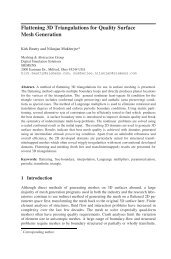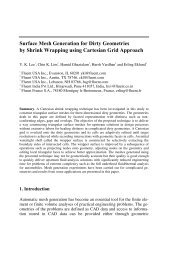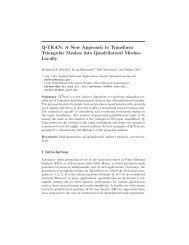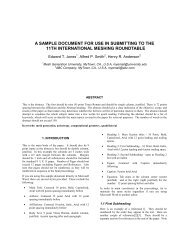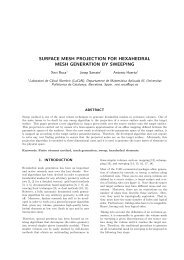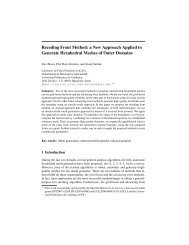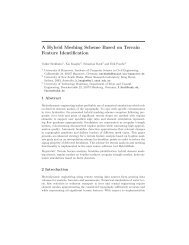Fitting Polynomial Surfaces to Triangular Meshes with Voronoi ...
Fitting Polynomial Surfaces to Triangular Meshes with Voronoi ...
Fitting Polynomial Surfaces to Triangular Meshes with Voronoi ...
Create successful ePaper yourself
Turn your PDF publications into a flip-book with our unique Google optimized e-Paper software.
12 Vincent Nivoliers, Dong-Ming Yan, and Bruno Lévy<br />
Fig. 7: Influence of the feature-sensitive fitting on meshes <strong>with</strong> sharp creases (from<br />
left <strong>to</strong> right: original mesh, result <strong>with</strong>out and <strong>with</strong> normal anisotropy).<br />
3.7 Implementation<br />
For the Delaunay triangulation, we use CGAL (www.cgal.org). For the Restricted<br />
<strong>Voronoi</strong> Diagram computation (Section 3.4) and the normal anisotropy<br />
(previous subsection), we use the implementation provided <strong>with</strong> [11].<br />
4 Results<br />
We shall now show some results obtained <strong>with</strong> VSDM. In the results herein,<br />
the regularization term is set <strong>to</strong> λ = 0.2 × 10 −3 , the normal anisotropy is<br />
set <strong>to</strong> s = 50 and subdivision surfaces are approximated by subdividing the<br />
control mesh twice. Figures 8, 9, and 10 show the result obtained <strong>with</strong> an<br />
initial <strong>to</strong>roidal grid. Note on Figure 12 how the spacing of the iso-parameter<br />
line adapts <strong>to</strong> the features. Scanned meshes from AimAtShape can also be<br />
efficiently processed (see Figure 13). For each model, the result was obtained<br />
in less than 3 minutes on a 2 GHz machine.<br />
Discussion and future work<br />
The examples shown in the previous section were obtained au<strong>to</strong>matically,<br />
by using the bounding box (or a <strong>to</strong>roidal mesh) as the initial control mesh.<br />
However, for shapes <strong>with</strong> an arbitrary genus or a complicated geometry, an<br />
initial control mesh is needed. Designing an initial control mesh may be also<br />
required <strong>to</strong> improve the quality of the surface. In future work, we will study<br />
the generation of an initial control mesh and/or the dynamic modification of<br />
the control mesh during the optimization.<br />
Acknowledgements<br />
The authors wish <strong>to</strong> thank Sylvain Lefebvre for a discussion (about an unrelated<br />
<strong>to</strong>pic) that inspired this work, Rhaleb Zayer, Xavier Goaoc, Tamy




